By Brooke Harris, New England Botanic Garden Staff
October 2023
As fall is in full swing, most people are winding down the gardening season, bringing their potted plants inside and gearing up for colder weather. With this introduction of the outdoors into your cozy space, you may notice some strange hitchhikers in your pots that you didn’t see before. The wet and humid conditions we saw this summer assist in fungal growth in your garden, but these organisms may have been established in your pots long before, just waiting for the right conditions to flourish and push out their mushrooms.
Although these strangers may be funny-looking, the presence of mushrooms in your pots can actually indicate soil and plant health, if you know what to look for. Here are five common types of fungal growth found in gardens and pots and what they might indicate for your plants.
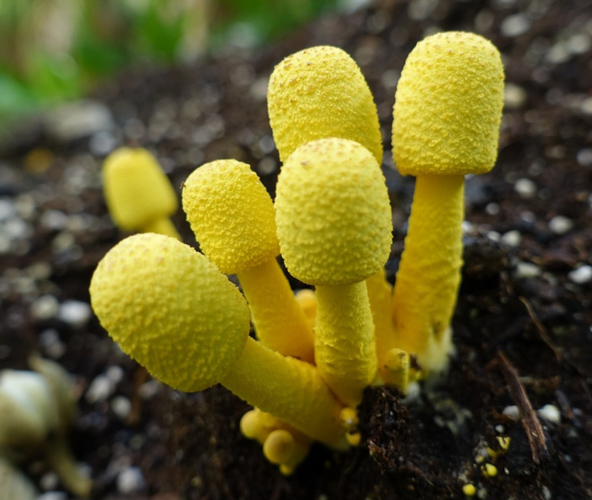
Flower pot parasol (Leucocoprinus birnbaumii), Scot Nelson, CC0, https://plants.ces.ncsu.edu/plants/leucocoprinus-birnbaumii/
Flowerpot parasols
One of the more common and colorful fungi that you may find in your potted plants is Leucocoprinus birnbaumii, or flowerpot parasols. These small, yellow, gilled mushrooms were first spotted in gardens and greenhouses as early as the late 1700s. Flowerpot parasols are saprotrophic mushrooms, meaning they digest spent organic material, and they can actually be beneficial to your plants despite their jarring visuals. They feed on dead or decaying matter, such as insects, potting material, or even rotting roots. The digestion of this potentially deleterious material by the fungi releases organic compounds back into the soil and provides your plants with nutrients. While they may be potential eye-sores to those who are squeamish, keeping them in your pots could provide long term benefits to your plants!
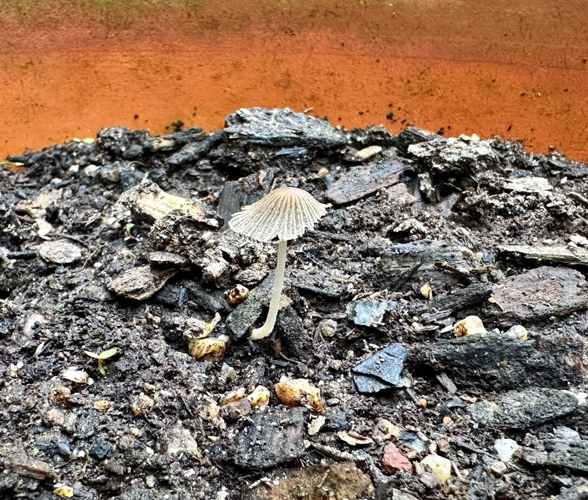
Little brown mushroom (Conocybe spp.), Brooke Harris
Little Brown Mushrooms
Conocybe species, commonly known as little brown mushrooms (“LBMs”) or cone heads, are another type of saprotrophic fungi that are regularly found in potted plants. While there are over 200 documented species, all of these long, thin capped mushrooms prefer feeding on decaying logs or dung. Conocybes make their way into your potted plants through spores found on nutrient rich soil that usually contains some sort of composted cow or goat manure. Similar to flowerpot parasols, these mushrooms will actually digest decaying organic material and re-release beneficial nutrients back into your soil making them non-harmful for your plants. However, there are some species native to the U.S., such as Conocybe filaris (a common lawn mushroom), that contain dangerous toxins, so it may be best to remove them if you have small children or animals roaming your house.
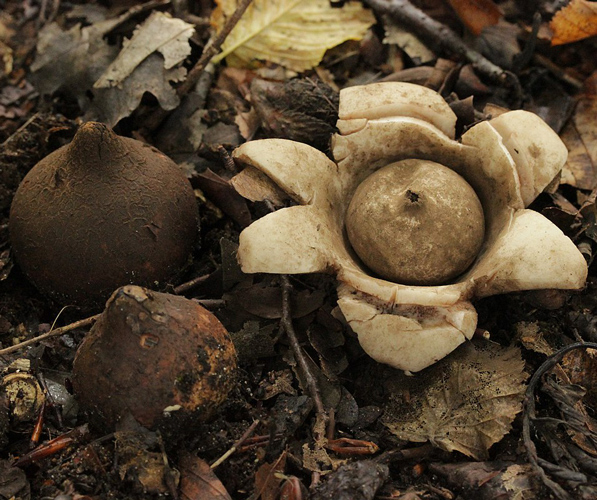
Collard earthstar (Geastrum triplex), bjoerns, iNaturalist, https://commons.wikimedia.org/wiki/File:Geastrum_triplex_157899228.jpg
Collard Earthstar
This flower shaped fungus, Geastrum triplex, is a puffball mushroom also known as a collared earthstar. Puffballs release their spores, or reproductive cells, through holes on the top of their fruiting body. This process is facilitated by rain or small animals squeezing the fungus and forcing the spores to shoot far distances. Geastrum triplex spores are non-toxic to humans and have actually been used as an anti-inflammatory in traditional medicine, but spore releases can be messy and leave a thin layer of residue on surrounding material. Like flowerpot parasols and LBMs, collared earthstars digest decaying organic material, such as leaf litter, and actually suggest a healthy soil composition despite their troublesome behavior. They are fine to leave in your pots — as long as you don’t mind spore cleanup during fruiting season!
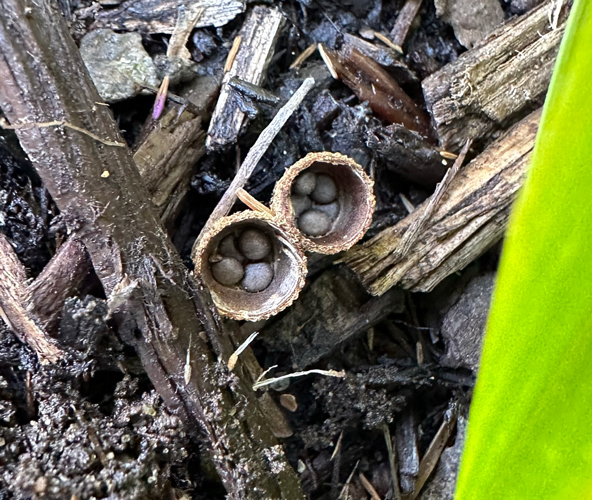
Bird’s nest fungus (Nidulariaceae spp.), Brooke Harris
Bird’s Nest Fungus
The genera Nidulariaceae includes a variety of species that are commonly known as bird’s nest fungus for their uncanny visual similarities to a tiny egg-filled bird’s nest. They are found in clusters and are common within gardens and potted plants. Interestingly, these mushrooms actually rely on rain to release their spores. The impact of the water droplets on the “eggs” can cause the “nests” to expel them over three feet in distance. The “eggs” will then decompose and release spores to this new location. These saprotrophs prefer feeding on decaying wood and soil containing wood chips or bark mulch, therefore are completely normal to see in your outdoor gardens. While these fungi are non-toxic to humans and animals, seeing them on your indoor plants might suggest the need for repotting, as wood chips and bark mulch do not make up the best soil composition for indoor plants.
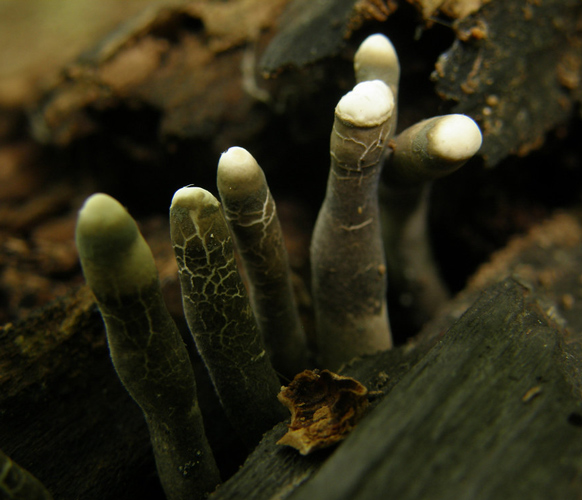
Dead man’s fingers (Xylaria polymorpha), Thiophene_Guy https://www.flickr.com/photos/7726011@N07/7781270666
Dead Man’s Fingers
The creepy-looking fungus Xylaria polymorpha is accurately nicknamed dead man’s fingers for its startling digit-like growth pattern. While these fungi are also saprotrophs, seeing them in your garden or indoor plants might be cause for some concern. Dead man’s fingers prefer to feed on decaying wood or unhealthy, rotting, or injured trees. The presence of this fungi might suggest some early stages of demise in your plant, so further inspection into the base or root system of your plant might be required to avoid any further loss. Cutting off dead or dying roots, and potentially splitting the plant where you see rot (if possible), might help save it from further decay.
Follow the Garden on social media @NewEnglandBG and subscribe to our enews for more horticulture tips, tricks, and insights like this!
Brooke Harris was a Conservatory Gardner at New England Botanic Garden at Tower Hill from 2021 to 2023. She oversaw the Limonaia, Winter Garden, and back of house greenhouses. Brooke earned her BA in Environmental Science Conservation Biology and MS in Biology from Clark University where she focused on ecology, entomology, and climate change studies. Her professional interests include ecological and biological research, integrated pest management, and sustainable environmental development practices.
